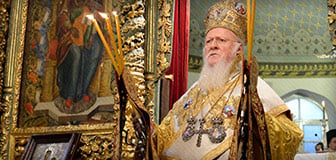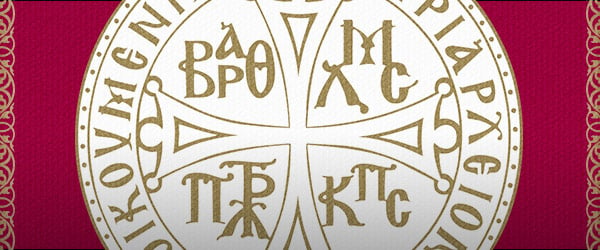The Church of Hagia Sophia, associated with one of the greatest creative ages of man, was also the Cathedral of the Ecumenical Patriarchate of Constantinople for more than one thousand years. Originally known as the Great Church, because of its large size in comparison with the other churches of the then Christian World, it was later given the name of Hagia Sophia, the Holy Wisdom of Christ, the second person of the Holy Trinity.
Justinian conceived the grandiose project of rebuilding the Great Church from its foundations. Nothing like it was ever built before or after. Construction work lasted five years [532-537] and on December 27, 537, Patriarch Menas consecrated the magnificent church.
The new Hagia Sophia belongs to the transitional type of the domed Basilica. Its most remarkable feature is the huge dome supported by four massive piers, each measuring approximately 100 square, m, at the base. Four arches swing across, linked by four pendentives. The apices of the arches and the pendentives support the circular base from which rises the main dome, pierced by forty single-arched windows. Beams of light stream through the windows and illuminate the interior, decomposing the masses and creating an impression of infinite space. Twelve large windows in two rows, seven in the lower and five in the upper, pierce the tympana of the north and south arches above the arched colonnades of the aisles and galleries. The thrust of the dome is countered by the two half-domes opening east and west, the smaller conchs of the bays at the four corners of the nave, and the massive outside buttresses to the north and south. The esonarthex and exonarthex, to the west, are both roofed by cross vaults. Two roofed cochliae [inclined ramps], north and south of the esonarthex, lead up to the galleries. The vast rectangular atrium extending west of the exonarthex had a peristyle along its four sides. At the center stood the phiale [fountain of purification] with the well known inscription that could be read from left to right and from right to left: "Cleanse our sins, not only our face".
The church measures 77 x 79 m. and the impressive huge dome soaring 62 m. above the floor has a diameter of about 33 m. According to R. van Nice, a scholar well versed in the problems posed by the architecture of Hagia Sophia. The nave is 38.07 m. wide, more than twice the width of the aisles, which measure 18.29 m. each. The vertical planes formed between the two north and the two south piers by the arcades of the aisles and galleries and the tympana above them are aligned flush with the side of the piers facing the nave. Thus, the mass of the piers is pushed aside into the aisles and galleries. By this clever arrangement the bearing structure is hidden from the eye, creating the impression that space expands in all directions and that the dome floats in the air.
At this point we would add the following historical evidence, which we believe will be found interesting. Written sources refer to "the number of clerics appointed to the service of the most holy Great Church of Constantinople. " The records list a total of 600 persons assigned to serve in Hagia Sophia: 80 priests, 150 deacons, 40 deaconesses, 60 subdeacons, 160 readers, 25 chanters, 75 doorkeepers. Another source reveals the extent of destruction and pillage which Constantinople suffered in the hands of the Catholic Crusaders after 1204 and the difficulties that the great church had to face from the 13th century onwards. Paspatis writes: "In 1396, during the patriarchy of Callistus II, a note was made in the second volume of patriarchal documents [Millosich-Muller] listing all the existing gold and silver sacred vessels, hieratic vestments, crosses, gospel-books and holy relics. The destitution of the celebrated church, looted by the Latin Crusaders became evident. I mention the most important objects, from which pillagers removed pearls and other ornaments of gold in later times. The church had: nine gospel-books, two of which remained in the church for the use of the priests, while the other seven much adorned the representations of embossed gold, were kept in the Skeuophylakion; five craters ...fourteen patens and chalices; six lavides [spoons]; six silver asterisks; four candelabra by the entrance; sixteen ripidia [fans]; eight crosses containing splinters of the True Cross and adorned with gold, silver and pearls; four aer [large veils]; twenty-six chalice veils and four patriarachal staffs; also a few icons, hieratic vestments and some relics of saints that had escaped the rapacious Crusaders..."
On Tuesday, May 29, 1453, Sultan Mehmet the Conqueror entered the vanquished city late in the afternoon and rode to Hagia Sophia. He was amazed at its beauty and decided to convert the Cathedral into his imperial mosque.

